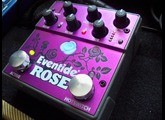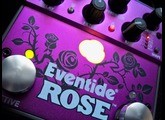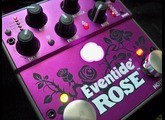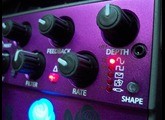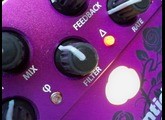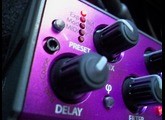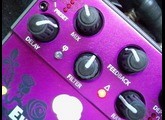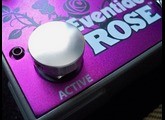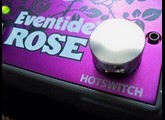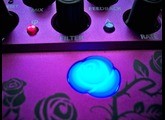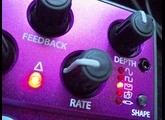« Unique and Awesome Sounding Modulated Delays »
Published on 07/04/19 at 05:28
Best value:
Correct
Audience:
Anyone
FYI… if you’re not into watching/listening to the entire demo, I encourage you to put on headphones and tune in around 10:15 for a sample composition with various Rose settings that was recorded with the Hooke Verse 3D audio headphones… listen as the binaural sounds swirl around your head!
SOUND:
Eventide is known for its digital effects, but this time the company has integrate analog with digital, thus resulting in a warmer and more organic sound (as opposed to its crystal clear digital fare). The dry path is analog, as is the Mix, Filter and Feedback components of this delay/modulation pedal.
The sounds produced range significantly. You can create very short delays in slap-back territory, but add in some modulation and the Rose becomes a chorus pedal. As with any delay there is a Feedback (repeat) knob, but also a low-pass Filter knob so that the effect can have a higher or lower pitch, great if you want the effect to jump out in the mix (more treble) or remain dark and mysterious in the background (more bass). Modulation shape can vary with a Sine, Square, Envelope or Random wave while affecting the Rate (pulse) and, of course, the overall Mix. One of my favorite features is the Infinite Repeat, which is like a freeze button (however, if you play over the freeze you do not hear the pedal’s effect – only a dry signal). To add to the diversity of the sound, there is a Reverse button, and also a Delay Multiply button, so that you can produce a 2x, 3x, 4x and 5x repeat for some very spacey time effects. Eventide did not stop there. You can save five presets, but each has an A/B option (which means two patches per preset). What makes this cool is that although you can switch between A and B with the Hotswitch footswitch, you also can morph the two with an Expression Pedal, thus producing some ultra-unique sounds limited only by your imagination.
OVERALL:
A combination of analog with digital, the dry path, mix, filter and feedback are analog, whereas the delay and modulation are digital. You can create utterly unique and fabulous sounds with delays that range from 10ms to 10 seconds, and even adding a reverse delay or inverting (flip phase) the delayed signal; and add a delay multiply (2x to 5x) for delays that last up to 50 seconds. Although you can achieve a lot of different delay ranges and results, when combined with the modulation component delays can range from subtle (chorus-like) to freaky spacey. Modulation includes sine, square, envelope and random waves that sweep from ½ to 2x the standard delay time, simultaneously modulating pitch across a full octave +/- (while controlling the depth and rate of the modulation). Both delay and modulation are controlled further with the Mix knob, but also the low-pass Filter knob (so that the wet signal ranges from a lot of treble vs. a lot of bass… clear or subdued). You can save 5 presets, although each has an A/B switching option (moreover, if using an expression pedal you can morph between the A and B settings). The Hotswitch footswitch can be assigned to different operations, including tap tempo, infinite repeat, LFO hold, LFO reset and A/B switching (in case you don’t have an expression pedal and want to flip between settings). Some additional features of the Rose include USB (for MIDI, software updates and to be used as a preset manager), a TRS input (for expression, auxiliary switch or MIDI), a selectable bypass (relay, buffered or input kill), and finally an input level select switch (line/instrument). At $349 USD the Rose brings with it a hefty price-tag, but compared to other high-end delays (with modulation and all the features of the Rose) you get a lot of bang for the buck and some very unique sounds.
GENERAL USE:
It will take a day of discovery to learn all the ins-and-outs, but a little bit of patience will make it all worth the effort as you can produce some utterly unique modulated delay effects. I won’t cover everything, but will go through some general guidelines. The delay knob allows you to select a ‘range’ by pushing down then turning the knob (the ‘range’ places you in a general area, e.g., 500ms delay); you then adjust the knob (without pushing) to fine-tune the milliseconds. Once you have a delay time you like (keep in mind you can tap tempo) you then can add a Reverse to the delay, besides adjust the Feedback (repeats) and even add a Delay Multiply (so that you hear your delay 2x to 5x). The amount of delay also is significant, ranging from 10ms to 10 seconds – add in a Delay Multiply the delay continues for nearly a minute even after you stop playing. Assign the Infinite Repeat to the Hotswitch and the signal will repeat forever (until you press the Hotswitch a second time, thus allowing the effect to trail off). Speaking of Hotswitch, you can assign many things to this footswitch besides an Infinite Repeat – you can use it as a tap tempo, use it to hold the modulation effect or reset the modulation (turn it on/off), and also use it to switch from a Preset’s A and B settings. In regard to the last assignment, if you have an expression pedal you can switch from A and B settings of a preset (heel down vs. toe down), but also morph the two into some fantastic sound-scapes (as you play and rock the treadle). The Modulation aspect of the Rose allows you to add various shapes to the delay tone, including a Sine, Square, Envelope or Random wave. You can adjust the depth of that shape, as well as its Rate (for a very slow wave to a fast pulse, as indicated by the Rose LED flashing to the set pulse or rhythm). Both the Delay and Modulation aspects can have a higher treble or bass response, whether you want it to be prominent and cut through the mix or remain dark and warm. And, of course, you can adjust the overall Mix so that even a complex sounding modulated delay remains nothing more than a hint in your tone.
OTHER DETAILS:
The Rose is a medium sized stomp-box, measuring 115 mm (W) x 120 mm (D) x 60mm (H) or (4.5 x 4.7 x 2.37 inches). The input impedance is 600K ohms (mono) and its output 470 ohms (mono). The heavy duty chassis has purple/pink top with a dark grey base. The six editing buttons are of heavy plastic and would withstand normal use and abuse. The two footswitches (Active and Hotswitch) are soft switches, viz., no click when engaged or disengaged – there is no popping or significant signal noise when switching. All inputs (cable inputs/outputs, expression pedal, USB, MIDI and power input) are located in the back of the Rose to save on pedalboard space and to prevent possible damage from regular stomping use. Any LED lights are low profile and are safe from damage from regular use. The Rose requires a 9VDC power supply while consuming 500mA of power – however, this pedal also comes with its own power supply.
SOUND:
Eventide is known for its digital effects, but this time the company has integrate analog with digital, thus resulting in a warmer and more organic sound (as opposed to its crystal clear digital fare). The dry path is analog, as is the Mix, Filter and Feedback components of this delay/modulation pedal.
The sounds produced range significantly. You can create very short delays in slap-back territory, but add in some modulation and the Rose becomes a chorus pedal. As with any delay there is a Feedback (repeat) knob, but also a low-pass Filter knob so that the effect can have a higher or lower pitch, great if you want the effect to jump out in the mix (more treble) or remain dark and mysterious in the background (more bass). Modulation shape can vary with a Sine, Square, Envelope or Random wave while affecting the Rate (pulse) and, of course, the overall Mix. One of my favorite features is the Infinite Repeat, which is like a freeze button (however, if you play over the freeze you do not hear the pedal’s effect – only a dry signal). To add to the diversity of the sound, there is a Reverse button, and also a Delay Multiply button, so that you can produce a 2x, 3x, 4x and 5x repeat for some very spacey time effects. Eventide did not stop there. You can save five presets, but each has an A/B option (which means two patches per preset). What makes this cool is that although you can switch between A and B with the Hotswitch footswitch, you also can morph the two with an Expression Pedal, thus producing some ultra-unique sounds limited only by your imagination.
OVERALL:
A combination of analog with digital, the dry path, mix, filter and feedback are analog, whereas the delay and modulation are digital. You can create utterly unique and fabulous sounds with delays that range from 10ms to 10 seconds, and even adding a reverse delay or inverting (flip phase) the delayed signal; and add a delay multiply (2x to 5x) for delays that last up to 50 seconds. Although you can achieve a lot of different delay ranges and results, when combined with the modulation component delays can range from subtle (chorus-like) to freaky spacey. Modulation includes sine, square, envelope and random waves that sweep from ½ to 2x the standard delay time, simultaneously modulating pitch across a full octave +/- (while controlling the depth and rate of the modulation). Both delay and modulation are controlled further with the Mix knob, but also the low-pass Filter knob (so that the wet signal ranges from a lot of treble vs. a lot of bass… clear or subdued). You can save 5 presets, although each has an A/B switching option (moreover, if using an expression pedal you can morph between the A and B settings). The Hotswitch footswitch can be assigned to different operations, including tap tempo, infinite repeat, LFO hold, LFO reset and A/B switching (in case you don’t have an expression pedal and want to flip between settings). Some additional features of the Rose include USB (for MIDI, software updates and to be used as a preset manager), a TRS input (for expression, auxiliary switch or MIDI), a selectable bypass (relay, buffered or input kill), and finally an input level select switch (line/instrument). At $349 USD the Rose brings with it a hefty price-tag, but compared to other high-end delays (with modulation and all the features of the Rose) you get a lot of bang for the buck and some very unique sounds.
GENERAL USE:
It will take a day of discovery to learn all the ins-and-outs, but a little bit of patience will make it all worth the effort as you can produce some utterly unique modulated delay effects. I won’t cover everything, but will go through some general guidelines. The delay knob allows you to select a ‘range’ by pushing down then turning the knob (the ‘range’ places you in a general area, e.g., 500ms delay); you then adjust the knob (without pushing) to fine-tune the milliseconds. Once you have a delay time you like (keep in mind you can tap tempo) you then can add a Reverse to the delay, besides adjust the Feedback (repeats) and even add a Delay Multiply (so that you hear your delay 2x to 5x). The amount of delay also is significant, ranging from 10ms to 10 seconds – add in a Delay Multiply the delay continues for nearly a minute even after you stop playing. Assign the Infinite Repeat to the Hotswitch and the signal will repeat forever (until you press the Hotswitch a second time, thus allowing the effect to trail off). Speaking of Hotswitch, you can assign many things to this footswitch besides an Infinite Repeat – you can use it as a tap tempo, use it to hold the modulation effect or reset the modulation (turn it on/off), and also use it to switch from a Preset’s A and B settings. In regard to the last assignment, if you have an expression pedal you can switch from A and B settings of a preset (heel down vs. toe down), but also morph the two into some fantastic sound-scapes (as you play and rock the treadle). The Modulation aspect of the Rose allows you to add various shapes to the delay tone, including a Sine, Square, Envelope or Random wave. You can adjust the depth of that shape, as well as its Rate (for a very slow wave to a fast pulse, as indicated by the Rose LED flashing to the set pulse or rhythm). Both the Delay and Modulation aspects can have a higher treble or bass response, whether you want it to be prominent and cut through the mix or remain dark and warm. And, of course, you can adjust the overall Mix so that even a complex sounding modulated delay remains nothing more than a hint in your tone.
OTHER DETAILS:
The Rose is a medium sized stomp-box, measuring 115 mm (W) x 120 mm (D) x 60mm (H) or (4.5 x 4.7 x 2.37 inches). The input impedance is 600K ohms (mono) and its output 470 ohms (mono). The heavy duty chassis has purple/pink top with a dark grey base. The six editing buttons are of heavy plastic and would withstand normal use and abuse. The two footswitches (Active and Hotswitch) are soft switches, viz., no click when engaged or disengaged – there is no popping or significant signal noise when switching. All inputs (cable inputs/outputs, expression pedal, USB, MIDI and power input) are located in the back of the Rose to save on pedalboard space and to prevent possible damage from regular stomping use. Any LED lights are low profile and are safe from damage from regular use. The Rose requires a 9VDC power supply while consuming 500mA of power – however, this pedal also comes with its own power supply.

